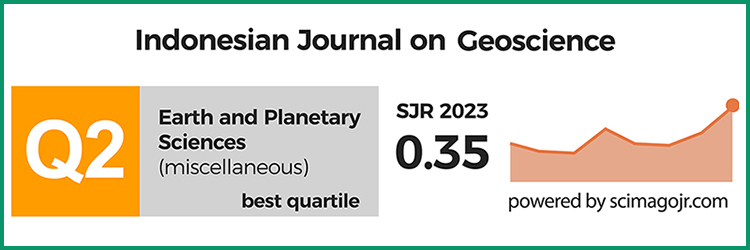Nose Structure Delineation of Bouguer Anomaly as the Interpretation Basis of Probable Hydrocarbon Traps: A Case Study on the Mainland Area of Northwest Java Basin
DOI:
https://doi.org/10.17014/ijog.7.3.157-166Keywords:
exploration concept, Bouguer and residual anomaly, nose structure, hydrocarbonAbstract
Two important aspects in the exploration of oil and gas are technology and exploration concepts, but the use of technology is not always suitable for areas with geological conditions covered by young volcanic sediments or limestone. The land of the Northwest Java Basin is mostly covered by young volcanic products, so exploration using seismic methods will produce less clear image resolution. To identify and interpret the subsurface structure and the possibility of hydrocarbon trap, gravity measurements have been carried out. Delineation of nose structures of a Bouguer anomaly map was used to interpret the probability of hydrocarbon traps. The result of the study shows that the gravity anomalies could be categorized into three groups : low anomaly (< 34 mgal), middle anomaly (34 - 50 mgal), and high anomaly (> 50 mgal). The analysis of Bouguer anomaly indicates that the low anomaly is concentrated in Cibarusa area as a southern part of Ciputat Subbasin, and in Cikampek area. The result of delineation of the Bouguer anomaly map shows the nose structures existing on Cibinong-Cileungsi and Pangkalan-Bekasi Highs, while delineation of residual anomaly map shows the nose structures occurs on Cilamaya-Karawang high. Locally, the gas fields of Jatirangon and Cicauh areas exist on the flank of the nose structure of Pangkalan-Bekasi High, while the oil/gas field of Northern Cilamaya is situated on the flank of the nose structure of Cilamaya-Karawang High. The concept of fluid/gas migration concentrated on nose structures which are delineated from gravity data can be applied in the studied area. This concept needs to be tested in other oil and gas field areas.
References
Achdan, A. and Sudana, D., 1992. Geologic Map of the Karawang Quadrangle, Java, scale 1:100.000. Geological Research and Development Centre, Bandung.
Adhidjaya J. I., Davioff, A. J., and Novianti I. R., 2002. PSDM Enhances reef Interpretation in Jatiluhur Block, West Java. Proceedings of 28th Annual Convention of Indonesia Petroleum Association, p.31-43
Bishop, M.G., 2000. Petroleum systems of the Northwest Java Province, Java and offshore Southeast Sumatra, Indonesia: Open file report, U. S. Geological Survey, 34pp.
Efendi, A.C., Kusnama, and Hermanto, B., 1998. Geologic Map of the Bogor, Java, scale 1:100.000. Geological Research and Development Centre, Bandung.
Koesoemadinata, R.P., 2011. The importance of new ideas in the development of hydrocarbon exploration concepts. Pemaparan Workshop roadmap eksplorasi hulu migas Kementerian ESDM, Jakarta 28 Juni 2011.
Martodjojo, S., 1994. Data Stratigrafi, pola tektonik, dan perkembangan cekungan pada jalur anjakan lipatan di Pulau Jawa, Kumpulan Makalah Seminat Geologi dan Geotektonik Pulau Jawa sejak Akhir Mesozoik hingga Kuarter, Geology Department, University of Gadjah Mada, P.15-26.
Panjaitan, S., 2009. Aplikasi metode gaya berat untuk identifikasi potensi hidrokarbon di dalam Cekungan Jakarta dan sekitarnya. Jurnal Sumber Daya Geologi, 19 (6), p.341-350
Pratcsh,1986. Bouguer anomaly map identify regional basin structure and resultant preferred directions of lateral oil and gas migration, IGC Footnote series, 3 (1), (https://www.igcworld.com, 1995).
Satyana, A.H. and Armandita, C., 2004. Deep-water play of Java, Indonesia: regional evaluation on opportunities and risks. Proccedings, International Geoscience Conference of Deepwater and Frontier Exploration in Asia and Australasia. Indonesian Petroleum Association and American Association of Petroleum Geologists, p.293-320.
Satyana, A.H., 2005. Oligo-Miocene Carbonates of Java, Indonesia: Tectonic - Volcanic setting and petroleum implications. Proceedings, 30th Annual Convention and Exhibition Indonesia Petroleum Association, p. 217-249
Sudjatmiko, 2003. Geologic Map of the Cianjur Quadrangle, Java, scale 1:100.000. Geological Research and Development Centre, Bandung.
Telford, W.M., Geldart, L.P., and Sheriff, R.E., 1990. Applied Geophysics, 2nd edition, Cambridge University Press, Cambridge.
Turkandi, T., Sidarto, Agus Setyanto, D.A., and Purbohadiwidjojo, M.M., 1992. Geologic Map of the Jakarta and Kepulauan Seribu Quadrangle, Java, scale 1:100.000. Geological Research and Development Centre, Bandung.



















